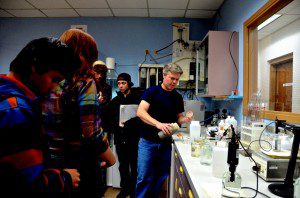30 Mar TELLURIDE MOUNTAIN SCHOOL INVESTIGATES LOCAL WATERSHED, PART FIVE
Editor’s note: For two weeks, Telluride Mountain School High School students put aside textbooks and turned their attention to water. With the help of local experts on water and media, they researched, wrote, and presented everything there is to know about Telluride water– where it comes from, how it’s cleaned, and what the fate of future snowpack is. This final entry, by sophomore Bella Hamm, is part five of a five-part series on Telluride water….
Bugs in Your Water
Bella Hamm
“On a scorching day in July, you are hiking the steep, colorful, and sunlit Cornet Creek trail in Telluride. It’s hot, you’re sweating, and you forgot a drink, and because of your tedious uphill activity, your buns are burning, and you’re thirsty. Darn! Fortunately, you look to your side to see an enticing, flowing mass of fresh water. Perfect to drink, huh? Not quite.”
I never really thought about, or even cared, where the water I use comes from or what made purified water “purified.” Water is water, and it’s as simple as that. But I was wrong. Water contains many microorganisms, vitamins, and bacteria which may be harmful to the human body. I will admit, ever since my class made a visit to Telluride’s water treatment plant in Lawson Hill, I can’t look at water the same way. Not only am I more aware of how fortunate I am to have clean water, I am also much more aware of how that water is cleaned in the first place.
Basically, our water here in Telluride is sanitized by teeny, tiny microorganisms, or—don’t freak out—bugs. These bugs eat away the bacteria in the water that are dangerous to our health. They rid the water of parasites and chemicals that can deteriorate a human body.
The bugs are placed in the water by the plant’s supervisors, and are managed by large and expensive machines that keep them moving throughout processes of the water treatment cycle.
Believe it or not, there are many different bugs, all of which kill different types of bacteria. The water treatment plant, however, doesn’t focus on the type of bugs put into the water, but on the amount of them. As the ski season starts up, or the music and film festivals begin, the town of Telluride is visited from people all around the United States. As the population in the town increases, so does the amount of fresh water being used. More water means more bugs. The experts working in the plant, such as Bill Goldsworthy, manage the amount of bugs as the population fluctuates.
See? Bugs aren’t so bad! They are helpful and essential to our drinking water, but must be placed in an environment suited for them and managed by professionals. So the next time you grab a glass of water, remember the microscopic organisms that made that possible—and if you’re hiking Cornet Creek trail, don’t forget to bring some of that treated water with you.
See all the photos and stories from the Telluride Mountain School water project here.




Sorry, the comment form is closed at this time.